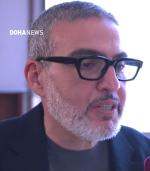Media
-
 Donald Trump sues BBC for £7.5bn over edited January 6 speech
Donald Trump has launched a £7.5 billion lawsuit against the BBC, accusing the public broadcaster of defamation and deceptive editing in a documentary examining the January 6, 2021, attack16 December 2025Read More...
Donald Trump sues BBC for £7.5bn over edited January 6 speech
Donald Trump has launched a £7.5 billion lawsuit against the BBC, accusing the public broadcaster of defamation and deceptive editing in a documentary examining the January 6, 2021, attack16 December 2025Read More... -
 Daily Mail owner agrees £500m deal to acquire Telegraph titles
The publisher of the Daily Mail has struck a £500 million agreement to buy the Telegraph newspapers, bringing an end to months of uncertainty over the titles’ future ownership.22 November 2025Read More...
Daily Mail owner agrees £500m deal to acquire Telegraph titles
The publisher of the Daily Mail has struck a £500 million agreement to buy the Telegraph newspapers, bringing an end to months of uncertainty over the titles’ future ownership.22 November 2025Read More... -
 BBC reports £1.1bn loss as licence fee income falls amid viewer exodus
The BBC has recorded a £1.1 billion loss as growing numbers of viewers either cancel or fail to pay the TV licence fee, according to a new parliamentary report.21 November 2025Read More...
BBC reports £1.1bn loss as licence fee income falls amid viewer exodus
The BBC has recorded a £1.1 billion loss as growing numbers of viewers either cancel or fail to pay the TV licence fee, according to a new parliamentary report.21 November 2025Read More... -
 Trump says he still plans to sue BBC, despite its apology
Donald Trump says he’s moving forward with legal action against the BBC next week, even though the broadcaster has already apologised for misleadingly editing one of his speeches.15 November 2025Read More...
Trump says he still plans to sue BBC, despite its apology
Donald Trump says he’s moving forward with legal action against the BBC next week, even though the broadcaster has already apologised for misleadingly editing one of his speeches.15 November 2025Read More... -
 BBC apologises to Trump for edited Panorama clip — but says it won’t pay damages
The BBC has apologised to US President Donald Trump after a Panorama episode stitched together parts of his 6 January 2021 speech in a way that could imply he was directly calling for14 November 2025Read More...
BBC apologises to Trump for edited Panorama clip — but says it won’t pay damages
The BBC has apologised to US President Donald Trump after a Panorama episode stitched together parts of his 6 January 2021 speech in a way that could imply he was directly calling for14 November 2025Read More...

Culture
-
 Cumbrian animated flood film scoops international science award
A short animated film featuring a red squirrel from Cumbria has won an international education award, shining a global spotlight on how trees can help tackle floodingRead More...
Cumbrian animated flood film scoops international science award
A short animated film featuring a red squirrel from Cumbria has won an international education award, shining a global spotlight on how trees can help tackle floodingRead More... -
 Inside an immersive Guildhall Art Gallery exhibition inspired by the London Tube
The sensory world of the London Tube is brought vividly to life in a new immersive exhibition at Guildhall Art Gallery, uniting painter Jock McFadyen RA with musicianRead More...
Inside an immersive Guildhall Art Gallery exhibition inspired by the London Tube
The sensory world of the London Tube is brought vividly to life in a new immersive exhibition at Guildhall Art Gallery, uniting painter Jock McFadyen RA with musicianRead More... -
 Researchers uncover ‘lost geometric code’ embedded in Oxford and Britain’s historic buildings
Researchers say they have uncovered a long-forgotten geometric code woven into some of Britain’s most famous historic buildings, including landmarks in Oxford.Read More...
Researchers uncover ‘lost geometric code’ embedded in Oxford and Britain’s historic buildings
Researchers say they have uncovered a long-forgotten geometric code woven into some of Britain’s most famous historic buildings, including landmarks in Oxford.Read More... -
 IWM Duxford to open new Second World War rooms revealing unseen artefacts and daily life of wartime pilots
IWM Duxford is set to open three newly restored Second World War spaces, offering visitors an intimate look at the lives of aircrew stationed at the Cambridgeshire airfield during the conflict.Read More...
IWM Duxford to open new Second World War rooms revealing unseen artefacts and daily life of wartime pilots
IWM Duxford is set to open three newly restored Second World War spaces, offering visitors an intimate look at the lives of aircrew stationed at the Cambridgeshire airfield during the conflict.Read More... -
 War-torn Trafalgar Union Flag faces possible departure from UK
A rare Union Flag that led the British charge at the Battle of Trafalgar has been placed under an export bar, giving UK institutions the chance to keep the historic relic in the country.Read More...
War-torn Trafalgar Union Flag faces possible departure from UK
A rare Union Flag that led the British charge at the Battle of Trafalgar has been placed under an export bar, giving UK institutions the chance to keep the historic relic in the country.Read More... -
 Barbican to host Liam Young’s first UK solo exhibition in 2026
The Barbican has announced ‘In Other Worlds’, the first UK solo exhibition by artist, director and BAFTA-nominated producer Liam Young. Opening May 2026, the immersive show will exploreRead More...
Barbican to host Liam Young’s first UK solo exhibition in 2026
The Barbican has announced ‘In Other Worlds’, the first UK solo exhibition by artist, director and BAFTA-nominated producer Liam Young. Opening May 2026, the immersive show will exploreRead More... -
 The Manchester Museum displays thousands of African artefacts it knows little about
A museum in northwest England has unveiled a new gallery showcasing thousands of African artefacts, many of which the institution admits it knows very little about. The exhibition aims toRead More...
The Manchester Museum displays thousands of African artefacts it knows little about
A museum in northwest England has unveiled a new gallery showcasing thousands of African artefacts, many of which the institution admits it knows very little about. The exhibition aims toRead More... -
 Captain John Narbrough’s journal faces export ban amid fears it could leave the UK
A rare 17th-century manuscript journal documenting Captain John Narbrough’s secret expedition to Spanish America and the Pacific has been placed under a temporary export ban, giving UKRead More...
Captain John Narbrough’s journal faces export ban amid fears it could leave the UK
A rare 17th-century manuscript journal documenting Captain John Narbrough’s secret expedition to Spanish America and the Pacific has been placed under a temporary export ban, giving UKRead More... -
 Earliest evidence of human fire-making unearthed in Suffolk
A team led by the British Museum has uncovered what is now the earliest known evidence of humans deliberately making fire—dating back around 400,000 years—at a site in Barnham,Read More...
Earliest evidence of human fire-making unearthed in Suffolk
A team led by the British Museum has uncovered what is now the earliest known evidence of humans deliberately making fire—dating back around 400,000 years—at a site in Barnham,Read More... -
 Rothschild 15th-century prayer book set to fetch up to $7 million at Sotheby’s auction
Ultra-rare 15th-century mahzor features vivid medieval illustrationsRead More...
Rothschild 15th-century prayer book set to fetch up to $7 million at Sotheby’s auction
Ultra-rare 15th-century mahzor features vivid medieval illustrationsRead More... -
 Ray Winstone honoured with Freedom of the City of London
Ray Winstone, one of the UK’s most celebrated ‘hard man’ actors, has been awarded the Freedom of the City of London in recognition of his extensive charitable and fundraising work.Read More...
Ray Winstone honoured with Freedom of the City of London
Ray Winstone, one of the UK’s most celebrated ‘hard man’ actors, has been awarded the Freedom of the City of London in recognition of his extensive charitable and fundraising work.Read More... -
 Golden Globe 2026 nominations announced ahead of January ceremony
The nominations for the 83rd annual Golden Globe Awards were unveiled on Monday, setting the stage for the first major awards ceremony of the season on January 11.Read More...
Golden Globe 2026 nominations announced ahead of January ceremony
The nominations for the 83rd annual Golden Globe Awards were unveiled on Monday, setting the stage for the first major awards ceremony of the season on January 11.Read More...

British Queen celebrates
Most Read
- Teen held after US woman killed in London stabbings
- Heave-ho Harry! Prince prepares to join the walking wounded in ice trek to North Pole
- Football: Farhad Moshiri adamant Everton deal above board
- "Master of English Style". Interview with Designer Lydia Dart
- Letter to the Financial Times from Lord Mayor Alderman Michael Bear
Education

The National Education Union (NEU) has recommended that its members in England reject a pay offer from the government. The offer includes a one-off payment of £1,000 ($1,227) this year

Westminster School, the prestigious private school located within the walled precincts of Westminster Abbey, has announced its plans to admit girls to all year groups for the first time.
Nearly one in five UK residents report intolerance to everyday sounds, Oxford University study finds

New research from the University of Oxford suggests that nearly one in five people in the UK find everyday sounds intolerable. According to the study, 18.4% of the general population

Stanton Williams, a London-based architecture firm, has won a competition to design a new library at Merton College, University of Oxford. The competition was held by one of the university's

Four academics who were forced to retire at the age of 68 have won their age discrimination claim against Oxford University. The academics successfully challenged the Employer Justified

The University of Leeds in the UK has settled a lawsuit for an undisclosed amount of money that claimed several professors had given a Jewish sociology student a failing mark for a paper that

Trinity College at Cambridge University has announced its plan to appoint an academic to a four-year post to examine the college's legacies of slavery. The Legacies of Slavery Research and

The University of Oxford has announced a new policy that will ban “intimate or close personal relationships” between staff and students. The policy will come into effect on 17 April and will

The London weekly: You are one of the few representatives of Ukrainian academic science actively promoting the image of Ukraine and interest in the country in Europe.

The UK government is investing £360 million in artificial intelligence (AI), nuclear fusion, and genetics to transform the country into a science ‘superpower’ by the end of the decade.






















